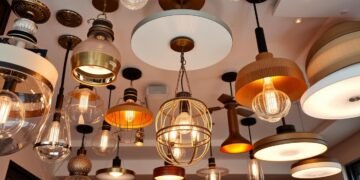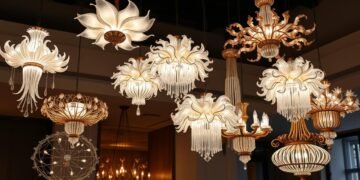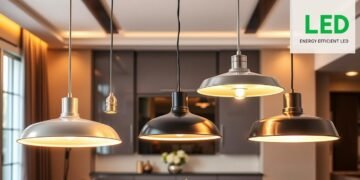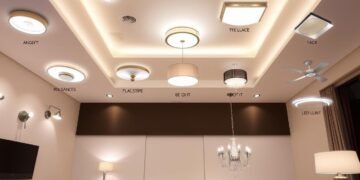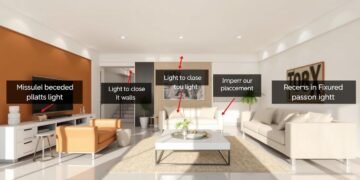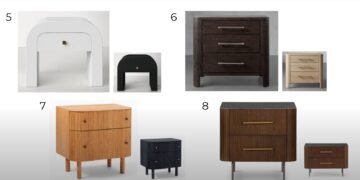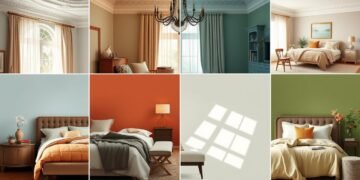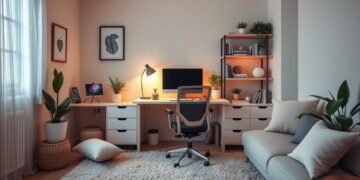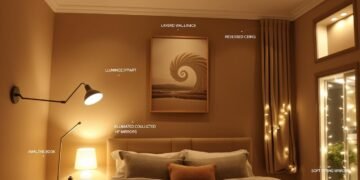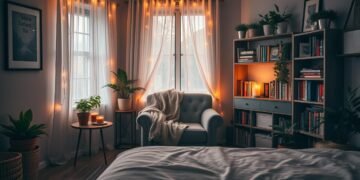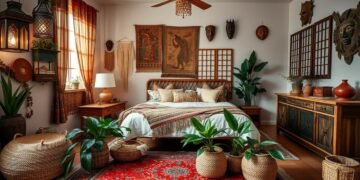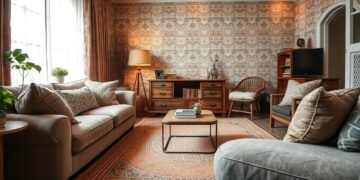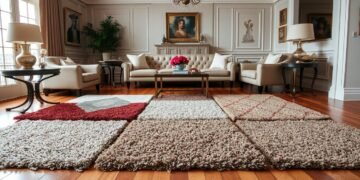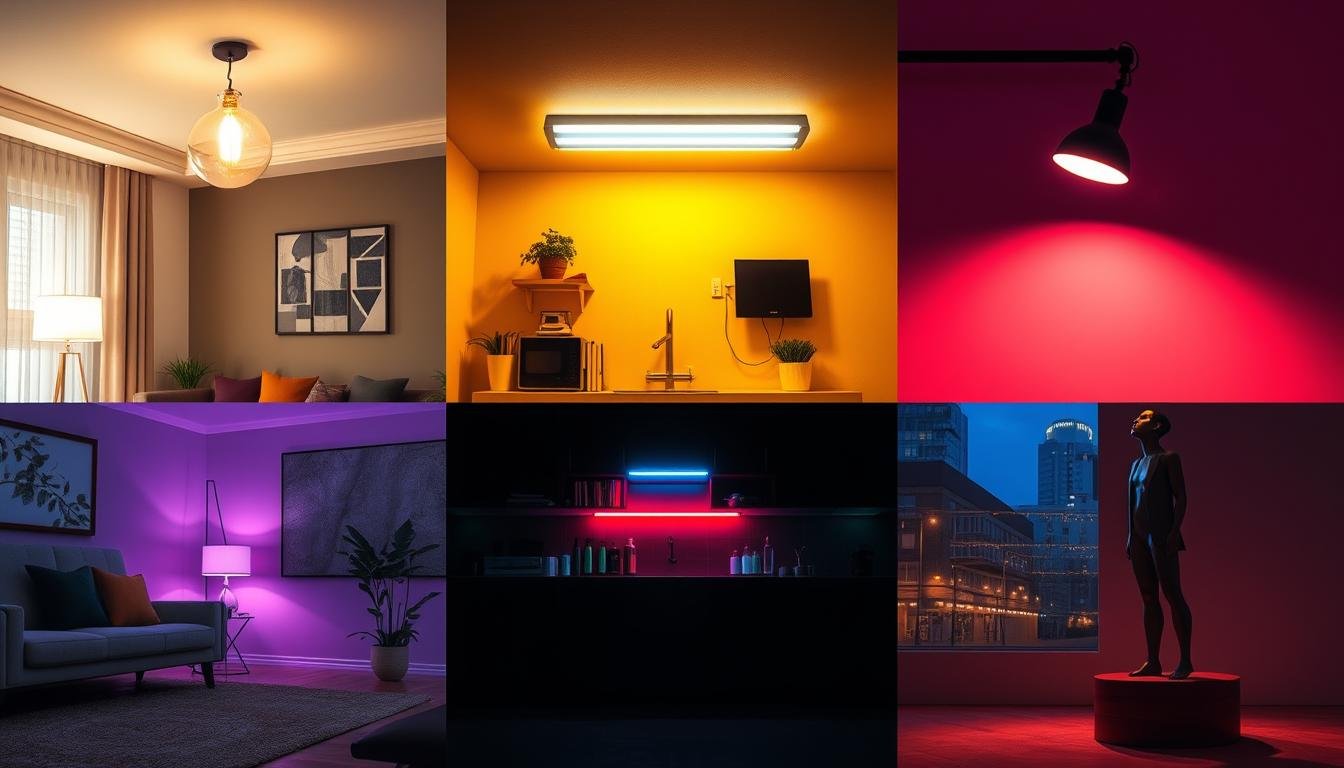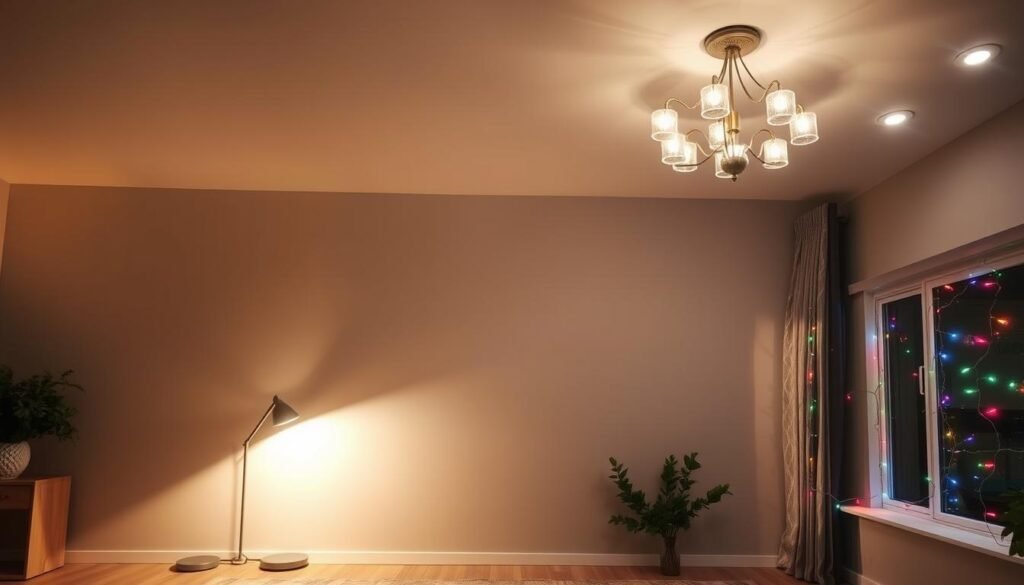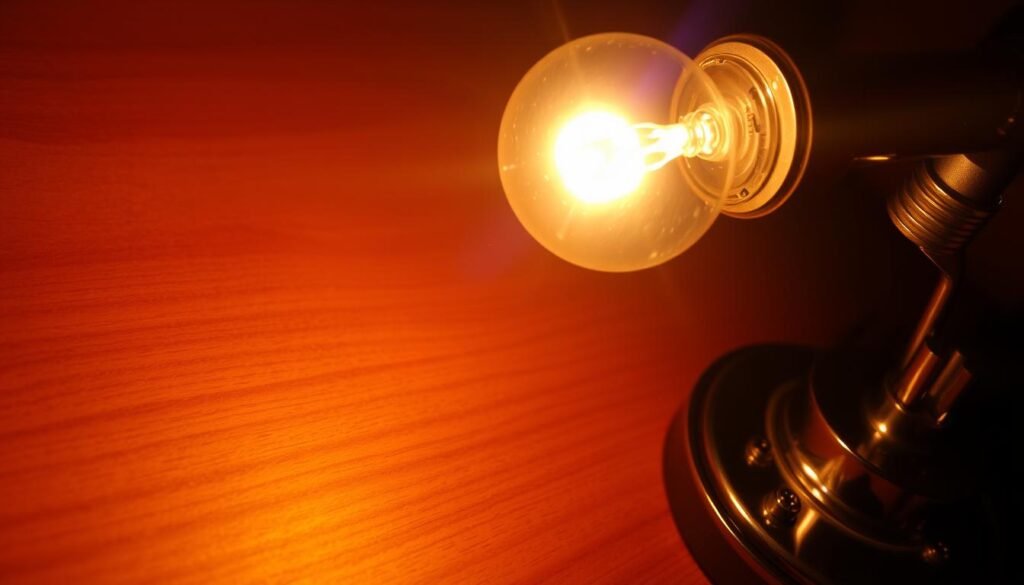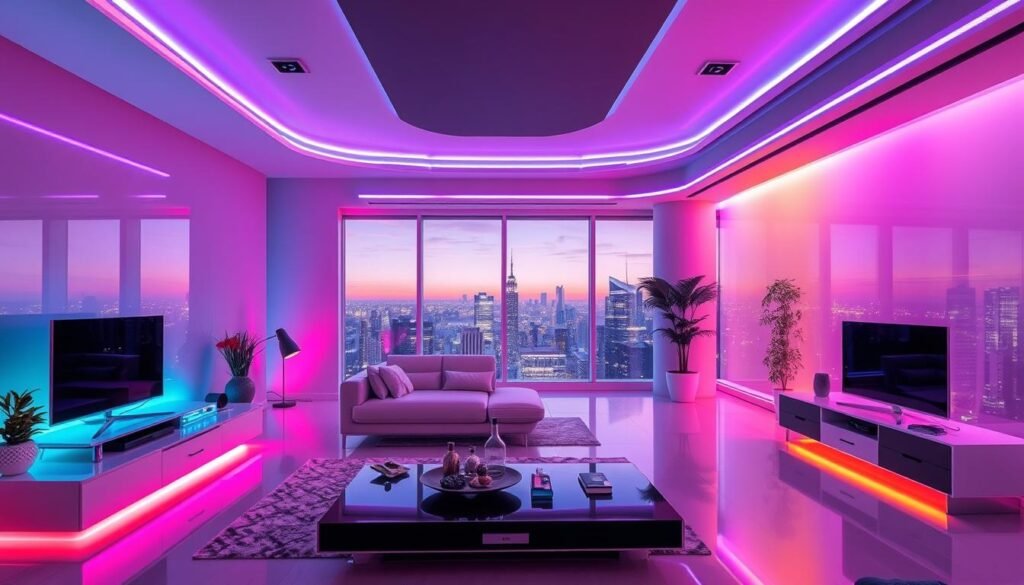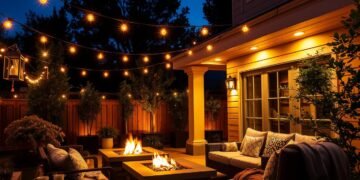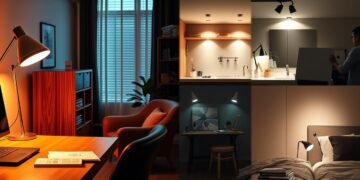Imagine walking into a room that feels warm and inviting. It’s perfectly set for whatever you need to do. The secret is in the right artificial lighting. It can change any space, making it look better and work better too.
As someone who owns a home or designs interiors, knowing about different lighting types is key. It helps create spaces that look great and work well.
In this guide, we’ll look at the five main types of artificial lighting. We’ll talk about when to use each one. Whether you want a cozy feel or need bright light for a task, the right lighting makes a big difference. Get ready to light up your space and make it shine.
Table of Contents
- 1 Understanding the Fundamentals of Interior Lighting
- 1.1 The Science Behind Artificial Light
- 1.2 Relatedarticles
- 1.3 7 Sustainable Lighting Options for an Eco-Friendly Home
- 1.4 6 Ideas for Outdoor & Patio Lighting to Extend Your Living Space
- 1.5 7 Methods to Incorporate Task Lighting for Greater Functionality
- 1.6 Impact of Lighting on Human Wellbeing
- 1.7 Key Lighting Terminology
- 2 Types of Artificial Lighting
- 3 Incandescent and Halogen Solutions
- 4 LED Lighting Revolution
- 5 Fluorescent and CFL Lighting Systems
- 6 Smart Lighting Technologies
- 7 Creating Layered Lighting Design
- 8 Energy Efficiency and Cost Considerations
- 9 Conclusion
- 10 FAQ
- 10.1 What are the three main types of artificial lighting?
- 10.2 How does artificial lighting impact human wellbeing?
- 10.3 What are the most common types of artificial light sources?
- 10.4 What are the benefits of LED lighting compared to traditional options?
- 10.5 How can layered lighting design improve functionality and ambiance?
- 10.6 What are the key considerations for choosing energy-efficient artificial lighting?
- 11 Source Links
Key Takeaways
- Ambient, task, and accent lighting are the three main types of artificial lighting. Each has its own purpose.
- LED, incandescent, and fluorescent lights offer different energy use and brightness levels.
- Using these lighting types together can make a space look and work better.
- Knowing what each lighting type does is important for the look and function you want.
- Smart lighting can give you more control and options for your lighting setup.
Understanding the Fundamentals of Interior Lighting
Artificial lighting is key in our daily lives. It helps or adds to natural light. To make good interior lighting, we need to know about light and how it affects us.
The Science Behind Artificial Light
The science of artificial light is about the light spectrum, intensity, and energy use. Each light source has its own colors based on its frequency and wavelength. Knowing color rendering index (CRI), lumens, and lux helps pick the right light for a space.
Impact of Lighting on Human Wellbeing
Lighting greatly affects our mood, work, and health. Good lighting makes us feel comfortable and well. Bad lighting can cause eye problems, headaches, and mess up our body clocks. It’s important to know how color temperature affects us for better spaces.
Key Lighting Terminology
- Lumens: A measure of the total amount of visible light emitted by a source.
- Lux: A measure of the intensity of light, or the amount of light falling on a surface.
- Color Rendering Index (CRI): A measure of a light source’s ability to accurately render the colors of various objects compared to natural daylight.
- Color Temperature: The perceived color of a light source, measured in Kelvins (K).
Knowing these basics is key for good interior lighting. It makes spaces look great and feel good for us.
“Utilizing wall washing can make a room or space feel larger by giving large surface areas a glow and even appearance, with light evenly spaced from above the surface.” – Jim McCarthy, senior market specialist for lighting manufacturer Eaton
By using these ideas in your design, you can make spaces that are both useful and beautiful. They will meet the needs of those who use them.
Types of Artificial Lighting
The world of artificial lighting is vast and varied. It ranges from incandescent lamps to LED lighting. Knowing about these different types helps you choose the right light for your space.
Incandescent lamps are classic but not very energy-efficient. CFLs and fluorescent tubes are better for saving energy. Discharge lamps, like sodium or metal halide bulbs, are very bright and last a long time. They’re great for big areas like warehouses.
Light Emitting Diodes (LEDs) are the latest innovation. They use very little energy, last a long time, and come in many styles. LEDs are perfect for any lighting need, indoors or outdoors.
| Lighting Type | Energy Efficiency | Lifespan | Common Applications |
|---|---|---|---|
| Incandescent Lamps | Low | Short | Residential, Decorative |
| Compact Fluorescent Lamps (CFLs) | Medium | Medium | Residential, Commercial |
| Fluorescent Tubes | Medium | Medium | Commercial, Industrial |
| Discharge Lamps | High | Long | Commercial, Industrial, Outdoor |
| LED Lighting | High | Long | Residential, Commercial, Industrial, Outdoor |
Each lighting type has its own benefits and drawbacks. It’s important to think about what you need and what you want your space to look like. By understanding these differences, you can create a lighting plan that works well and looks good.
Incandescent and Halogen Solutions
Thomas Edison invented incandescent lamps in 1880. They use a tungsten filament to light up. These bulbs give off a warm, nice glow. But, they are very energy-inefficient, only turning 15% of their energy into light and a lot of heat.
Halogen lamps are a newer version of incandescent bulbs. They have a special halogen gas inside. This lets them work at higher temperatures, lasting longer and being more compact. Halogens are known for their bright light output and great color rendering. They are often used in homes, offices, and special places for their quality.
| Feature | Incandescent | Halogen |
|---|---|---|
| Lifespan | 800-1,200 hours | 2,500 hours |
| Luminous Efficiency | 15 lumens/watt | 25 lumens/watt |
| Color Rendering Index (CRI) | 100 | 100 |
| Energy Consumption | High | Moderate |
Both incandescent and halogen lamps create a cozy atmosphere. But, they use a lot of energy. This has made people choose more energy-efficient options like LED and compact fluorescent bulbs.
“Halogen lamps are recommended for residential or decorative purposes by lighting specialists and designers.”
LED Lighting Revolution
The lighting world is changing fast, thanks to light-emitting diode (LED) technology. LEDs turn electrical energy into light using semiconductors. They offer energy efficiency, long lifespan, and many color options.
The global LED lighting market is set to hit $33.1 billion by 2023. This growth is huge, showing LEDs are taking over. They use way less energy than old bulbs and last much longer.
LEDs are making a big difference everywhere. In offices, they cut down electricity use for lighting from 40% to just 6-8%. They could save the U.S. about $250 billion in energy costs over 20 years.
LEDs are getting better, with new sizes and smart lighting features. They’re being used in fabrics and buildings, and even in laser lighting. The future of light is all about LEDs.
“The transition to LED technology has the energy costs over the next two decades.”
LEDs are not just about saving energy and lasting long. They open up new ways to light our world. LEDs let us control light color, intensity, and direction. This makes lighting for health care and city planning better.
Fluorescent and CFL Lighting Systems
Fluorescent lighting is very efficient and saves money. It’s often used in offices and commercial places. These lights use mercury vapor and a special coating to shine bright and evenly.
Linear fluorescent tubes are usually seen in overhead lights. They help with both task and ambient lighting in many areas.
Fluorescent Tube Applications
Fluorescent tubes come in different sizes and colors. They’re great for office and retail lighting. High-output T5 tubes last up to 90,000 hours, perfect for big spaces.
Switching to fluorescent lights can cut energy costs by up to 40%. This is a big win for businesses.
Compact Fluorescent Benefits
Compact Fluorescent Lamps (CFLs) are energy-saving bulbs for homes. They use up to 75% less power than old bulbs. CFLs also come in many colors to match your home’s feel.
Commercial vs Residential Use
Fluorescent lights are common in offices, but CFLs are more popular at home. CFLs fit easily into existing light fixtures. But, remember the mercury in these bulbs and how to recycle them.
| Lighting Type | Energy Savings | Typical Applications |
|---|---|---|
| Fluorescent Tubes | Up to 40% energy savings | Commercial offices, retail stores, warehouses |
| Compact Fluorescent Lamps (CFLs) | Up to 75% energy savings | Residential lighting, small-scale commercial spaces |
“Fluorescent lighting is known for its energy efficiency and cost-effectiveness, making it a popular choice for commercial and office settings.”
Smart Lighting Technologies
The world of lighting is changing fast, thanks to IoT (Internet of Things) and smart tech. These new solutions are changing how we use and manage lights at home and work. They let us change light colors and control them with our voices, making our spaces more personal and efficient.
At the heart of this change are LED (Light-Emitting Diode) technologies. They work with smart homes to let us adjust lights easily. Whether you want a cozy evening or a productive workspace, smart lighting gives you the control you need.
Smart lighting also saves a lot of energy. It adjusts light levels and schedules to cut down on power use. This makes it a key part of living sustainably and automating our homes. It uses sensors and AI to learn our habits and save energy.
| Feature | Benefit |
|---|---|
| Color-changing lights | Enhance ambiance and set the perfect mood for any occasion |
| Voice control | Convenient and hands-free lighting management |
| Scheduling and automation | Optimize energy usage and create personalized lighting routines |
| Remote access | Manage your lighting from anywhere, even when you’re away from home |
As we all get used to smart tech, lighting is leading the way. With IoT and advanced LEDs, smart lighting is changing how we live and work. It’s making our spaces more sustainable and tailored to our needs.
“The integration of smart lighting with IoT systems is a game-changer, making it easier to control and customize lights in any space.”
Creating Layered Lighting Design
Creating a good lighting design means balancing three types of light: ambient, task, and accent. This balance makes your space look good and work well for you.
Ambient Lighting Techniques
Ambient lighting is the main light in a room, giving it a general glow. Use warm colors (2700K-3000K) for fixtures like floor lamps and chandeliers. This makes the room feel cozy and welcoming.
Task Lighting Implementation
Task lighting is for areas needing brighter light, like reading spots or kitchen counters. Choose cooler colors (3500K-4000K) here to help you work better and see more clearly.
Accent Lighting Strategies
Accent lighting highlights special features or art. Use bulbs that are brighter than the room’s main light to catch your eye. Smart controls let you change this light easily to fit your mood.
By mixing these three lights – ambient, task, and accent – you make a space that looks great and works well. It’s perfect for places that do many things.
| Lighting Layer | Purpose | Color Temperature | Example Fixtures |
|---|---|---|---|
| Ambient | Overall illumination | 2700K-3000K | Floor lamps, recessed lights, chandeliers |
| Task | Focused illumination for specific activities | 3500K-4000K | Reading nooks, kitchen counters, bathroom vanities |
| Accent | Highlight architectural features or artwork | Varies | Directional spotlights, wall sconces |
Energy Efficiency and Cost Considerations
Modern lighting design focuses a lot on energy efficiency. LEDs can cut energy use by up to 75% compared to incandescent bulbs. They also last 25 times longer, as the U.S. Department of Energy reports. Even though LEDs cost more upfront, they save money over time due to lower energy and replacement costs.
Lighting laws are pushing for more efficient options, like LEDs, over incandescent bulbs. This change helps the planet and your wallet. By choosing LEDs, you’ll save on energy bills and help the environment.
| Lighting Technology | Energy Consumption | Lifespan | Cost-Effectiveness |
|---|---|---|---|
| Incandescent Bulbs | High | Short | Low |
| LED Bulbs | Low | Long | High |
Switching to energy-efficient lighting cuts down on energy consumption and saves money on bills. LEDs might cost more at first, but they’re a smart choice for homes and businesses.
“Lighting accounts for around 15% of an average home’s electricity use. The average household saves about $225 in energy costs per year by using LED lighting.”
Conclusion
The future of lighting is all about being energy-efficient, customizable, and connected. We’re seeing big changes with LED lights and smart lighting. These changes are happening in both homes and businesses.
When you’re working on a lighting project, knowing the basics is key. This includes understanding color, lifespan, and what each space needs. This knowledge helps you create lighting that looks good and works well, while also being kind to the planet.
Technology is making lighting better in many ways. By choosing smart and green lighting, we can make spaces that are good for us and the environment. Explore the world of lighting to make your spaces better, whether for work or relaxation.
FAQ
What are the three main types of artificial lighting?
How does artificial lighting impact human wellbeing?
What are the most common types of artificial light sources?
What are the benefits of LED lighting compared to traditional options?
How can layered lighting design improve functionality and ambiance?
What are the key considerations for choosing energy-efficient artificial lighting?
Source Links
- Artificial Lighting Types and Design
- Types of artificial lighting in architecture
- Shine On: Fundamentals of Lighting Architectural Elements – Architizer Journal
- Residential Lighting Design – The Basics | Studio N | Lighting Design & Supply
- Importance of Lighting in Interior Design | John Cullen Lighting
- Artificial lighting
- Photography artificial lighting: Four basics to learn
- What is Artificial Lighting?
- LED & Artificial Light Guide
- What is halogen and how is it different than incandescent?
- Different Types of Lights
- The LED light revolution has only just begun
- The lighting revolution
- History of LED Technology – Infineon Technologies
- What is fluorescent lighting?
- Types of lighting – LightAware
- Artificial Lighting – Know Everything About Its Use And Origin
- Enhanced smart lighting systems to save energy for buildings | Consulting – Specifying Engineer
- Lighting for Multi-Functional Spaces | Crown Lighting Group
- The basics of layered lighting
- Lighting Choices to Save You Money
- Lighting Design
- Importance of Lighting | Natural & Artificial Lighting & architecture
- Types of Lighting | General, Accent and Task Lighting
- How to Balance Natural Light with Artificial Lighting in the Kitchen?
